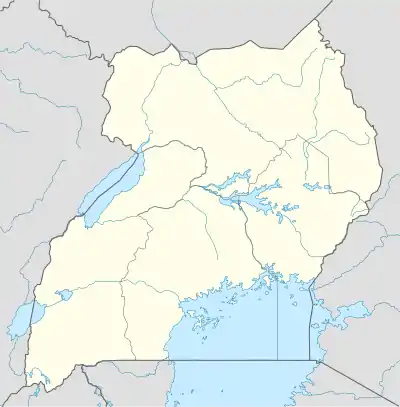Kyangwali Refugee Settlement
Kyangwali Refugee Settlement is a refugee camp in Kikuube District (formerly Hoima District) in western Uganda.[2]
Kyangwali Refugee Settlement | |
|---|---|
 Kyangwali Refugee Settlement | |
| Coordinates: 1.22°N 30.82°E | |
| Population (2015)[1] | |
| • Total | 38,136 |
Background
Kyangwali refugee settlement was established in the 1960s to accommodate Rwandan refugees. After many Rwandans repatriated voluntarily in 1994, the settlement has hosted mostly Congolese refugees. South Sudanese and Congolese (DRC) refugees first entered Kyangwali in 1996 and 1997 respectively. By 2002, the population was slightly above 40,000 refugees with majority South Sudanese; however, when South Sudan gained independence from Sudan in 2011, many South Sudanese Refugees in Kyangwali Refugee Settlement repatriated leaving the Settlement to be dominated by Congolese. This repatriation led to the drop in the number of refugees to slightly above 20,000 people but the start of a new refugee influx from the Democratic Republic of Congo (DRC) in mid December 2017, has nearly doubled the refugee population in Kyangwali from 36,713[3] in December 2017 to 109,207 in the end of July 2019.[4] Kyanwali refugee settlement now hosts over 30,000 refugees from Congo, Rwanda, Burundi, South Sudan, Somalia, and Kenya[5]
Water and Sanitation
Kyangwali refugee camp boasts as one of the best refugee settlement camps in the world with clean water supply, well developed sanitation facilities that are easily accessible by vulnerable people like the disabled, schools that have been commended for their good performance, security and fertile land where refugee families can grow their crops and hospitals and medical centers are all the good things that you can get from this refugee settlement.
Social Services
Kyangwali Refugee Settlement has over 30 relief agencies trying to support refugees. These work as either implementing partner or operating partner with UNHCR. The feeling by most of the elite refugees that the agencies promise donors more than what they actually deliver has led to the formation of more than 20 Community Based Organisations. Although majority of these refugee founded rely on community resources and the support of the refugee population to help the most vulnerable among[6] themselves,[7] Some of the organisations such as CIYOTA, P4T, RAA-U have gone an extra mile to gain national and/or international recognition by UNHCR, World Bank, and other agencies and donors.
News for the Kyangwali refugee community Kyangwali Star is the news agency working inside the refugee settlement of Kyangwali, Hoima district, Uganda to educate and inform the local population of the ongoing events such that the people are informed and delivered the right information.[8]
Strong coordination structures across implementing partners, the United Nations High Commissioner for Refugees, Uganda's Office of the Prime Minister, and the local government, contributes to a response that is robust and adaptable. This strength was demonstrated in the effective cross-sectoral mass mobilization response to the cholera outbreak.
Kyangwali refugees were given a piece of land to farm their own food to eat. Later, when established as a youth organization, were able to request land to farm and to build a youth centre, the COBURWAS Learning Centre and contributes as a refugee partner in the implementing.[9]
Nutrition and Health
Refugees reported a lack of nutritional diversity in food distribution and inconsistent ration sizes of maize, flour, and beans. However, full food rations are provided on a monthly basis either in-kind or cash. With residents unable to gather sufficient wood for cooking, food preparation is an issue.[10]
Cholera and diarrheal illnesses have spread across the settlement leading to high level of mortality. This has been exacerbated by insufficient household latrines, the sharing of communal block latrines, inadequate water and soap supplies, and limited water, sanitation, and hygiene (WASH) awareness programs.[11]
Insufficient medical personnel and infrastructure in the Health Centres has affected Refugees reporting that some ill patients end up sleeping on clinic floors due to lack of sufficient beds, including children, pregnant women, and elderly refugees with no separate quarters. Limited diagnostic equipment, translation issues, and a lack of medication have also contributed to poor health services for the population in the Kyanwali refugee settlement.[12]
References
- "Uganda - Hoima - Kyangwali". DRC Regional Refugee Response Information Sharing Portal. UNHCR. Retrieved 7 June 2016.
- "Uganda - Hoima - Kyangwali". DRC Regional Refugee Response Information Sharing Portal. UNHCR. Retrieved 7 June 2016.
- "Uganda Refugee Response Monitoring Settlement Fact Sheet: Kyangwali (March 2018) - Uganda". ReliefWeb. Retrieved 2019-09-08.
- "Country - Uganda". ugandarefugees.org. Retrieved 2019-09-08.
- "The Case of Kyangawali Refugee Settlement and the Locals – Ticking time bomb? – Centre for Policy Analysis". Retrieved 2020-09-26.
- "History and Development". www.coburwas.org. Retrieved 2019-09-08.
- "Planning For Tomorrow Youth Organisation | Corporate NGO partnerships". www.globalhand.org. Retrieved 2019-09-08.
- "Government services in Musaffah". www.govserv.org. Retrieved 2020-09-25.
- "Uganda Refugee Response Monitoring Settlement Fact Sheet: Kyangwali (March 2018) - Uganda". ReliefWeb. Retrieved 2020-09-25.
- "Uganda Refugee Response Monitoring Settlement Fact Sheet: Kyangwali (March 2018) - Uganda". ReliefWeb. Retrieved 2020-09-25.
- "Uganda Refugee Response Monitoring Settlement Fact Sheet: Kyangwali (March 2018) - Uganda". ReliefWeb. Retrieved 2020-09-25.
- "Uganda Refugee Response Monitoring Settlement Fact Sheet: Kyangwali (March 2018) - Uganda". ReliefWeb. Retrieved 2020-09-25.